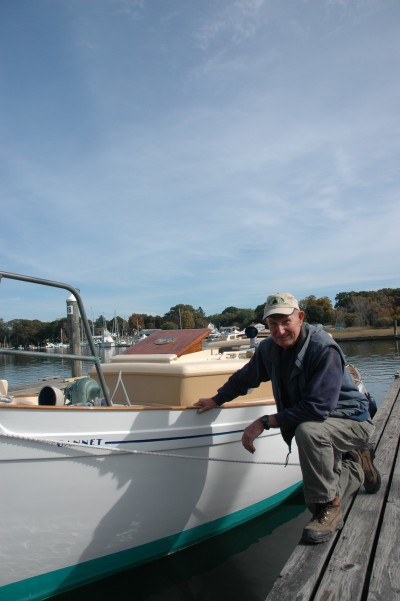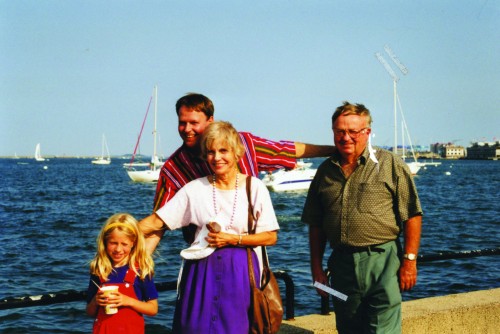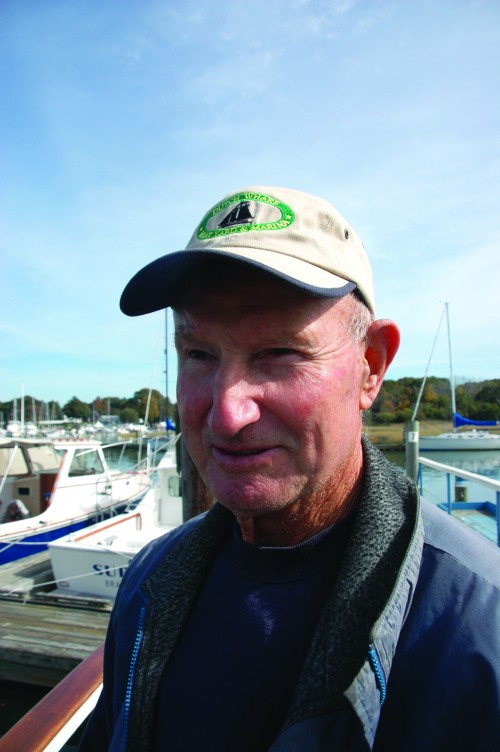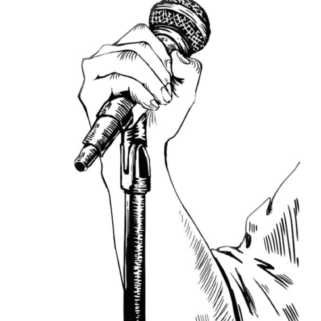I find Bill Clapp standing fifteen feet above the saltwater tides of the Branford River, his reed-thin frame shadowy against a darkening October sky. A thunderstorm is brewing, but Clapp, on the platform of Dutch Wharf Marina’s enormous hydraulic boatlift, has eyes only for the sailboat he is carefully raising from the water. It is a delicate task; the boat weighs more than six tons. Below him, Clapp’s coworkers scramble on the deck. They crane their necks and call up to him: “This go here, Bill?” “How’s it look from up there, Bill?”
“We good?” Clapp calls down.
“We’re good.” It begins to drizzle just as the hull of the sailboat clears the riverbank, and the men on the docks exchange glances. “Bill, you know it’s lunchtime?”
“It is?” Up above us, a sailboat in his hands, Clapp has lost track of time. The rain falls harder, sweeping across the water in heavy sheets, but he simply flicks his rubber hood over his head. His fingers return to the levers of the lift. Almost eagerly, he says, “Give me a few more minutes.”
They call Bill Clapp the guardian angel of the boatyard. After twenty-two years at Dutch Wharf, he is more than qualified to work as a supervisor or yard foreman, but, as he sheepishly says, he’s “not the management type.” Clapp is nobody’s boss. Managers spend most of their time inside a neat, carpeted building, making phone calls and tapping at keyboards. Clapp does everything else. In the winter, he repairs boats, sanding and polishing their wood, replacing rotted planks and varnishing masts. He resurfaces decks, sairs keels, and carves tillers. In the fall, he lifts, cleans, and transports the boats, storing them on spindly metal legs, or boat stands, until they fill the sprawling gravel lot.
In the past few weeks, Clapp has lifted stubby lobster boats, tall, angular fishing craft, and sleek powerboats, but mostly he lifts sailboats: yawls, schooners, sloops, ketches. In the yard, from among rows of mass-produced white fiberglass hulls, it is the wooden crafts that stand out, like redwoods growing between buildings of glass and cinderblock. Bill Clapp loves all boats, but these are his obsession.
“A wooden boat is a living thing,” Clapp has told me. He meant that wooden boats speak to him—of history, devotion, mastery, and craftsmanship. They are the reason why, at 75 years old, he is still here. Still the last one in to lunch, even on days like today, when all he has on his agenda is hours of strenuous manual labor and freezing rain.
I am fourteen. My grandparents are out alone on the lake when their boat, a fiberglass ketch that my grandpa bought a few months earlier, capsizes. My grandpa has been a sailor all his life, but he has never owned a fiberglass boat before, and it’s more temperamental than his wooden boats—too difficult for an eighty-two-year-old man to control. The water is cold. By now, after years of being medicated for bipolar disorder, my grammie is even frailer than she was in my childhood. Her hair is colorless, her skin pale, her body wrapped in an oversized purple cardigan to keep warm. She loses consciousness and slips beneath the water, and my grandpa, clinging to the side of the boat, cannot hold her up. What hurts most, when my mom tells me what happened, is imagining how afraid they were.

“I’ve always been on the water,” Clapp told me once. “And I’ve always had a boat.”
Clapp grew up in a narrow white house overlooking the Farm River, which stretches lazily from Lake Saltonstall down through olive-colored saltwater marshes and into Long Island Sound. He had a small wooden skiff, graying from age, that he poled into the Farm River Gut to swim and crab with other boys, and to jump off of dikes built to hold back floods. When he was 8 years old, Clapp realized he and his skiff could go faster if he “used the wind,” and he strung a bedsheet onto the poles. From then on, he sailed.
At 14, Clapp bought his second boat with the salary he earned teaching sailing to the wealthy patrons of a local yacht club, and kept it until 1954, when entered SUNY Maritime College. He sailed in the US Navy and spent two years living on boat number three, a hulking cable-laying ship that was tethered to the ocean floor for hundreds of miles. Clapp told me he liked it—liked the camaraderie, the rush he felt when the captain put him in charge of the craft.
Clapp married his high school sweetheart, Sis, after two years in the US Navy. “That was the end of my going to sea,” he said wistfully. He got an office job and his fourth boat, a 28-foot ketch that made Clapp’s days as an engineer at Southern Connecticut Telephone Company bearable. In the summer, he stored up vacation time to take his family—Sis and their son and daughter—on long “cruises” to Martha’s Vineyard and the Cape. Those were the times when Clapp was happiest.
After twenty-six years working his way up at the telephone company, Clapp got out as soon as he could. He took a golden handshake and, instead of retiring, went to work at Dutch Wharf.
Then came Tern. The boat belonged to the founder of Dutch Wharf, who passed the boat—and the yard—along to his son, Paul, after his death. It was a 28-foot Hereshoff Rozinante ketch, built only for, as Paul says, “the most experienced of sailors”—no motor, no lifelines, so light and sleek that it could be caught up in even the slightest of breezes. Even Paul couldn’t sail it. He sold the boat to Clapp, his most trusted employee, with the understanding that he was passing on a legacy.
“It was like he was bringing my father back, in a way,” Paul told me.
Clapp kept Tern for nineteen years. In the summers, he worked at Dutch Wharf until noon, then returned home. He swam out to where he kept Tern moored in a cove and sailed all afternoon, sometimes cruising up the Long Island Sound, other times simply tracing the waters of the bay he had sailed since he was a boy. Even in the wintertime, Clapp and Tern were rarely apart. In the basement of his Branford home, he crafted and customized its every feature: teak wedges to keep the anchor from rocking, a constellation compass in the cockpit sole, a wood-fired stove.
When Clapp’s grandchildren began to sail, Sis demanded he replace the Tern with something safer—the 25-foot teak Vertue, a solid, heavy boat originally built to weather the storms of the English Channel. Stowed in its hull is a noisy, bulky motor.
I am four. Grammie is standing at the counter of my grandpa’s boat, the Squidulum, holding a paper bag from Dahl’s Foods. We are alone in the cabin and she is wearing purple. From the bag, she takes a Tupperware container of homemade coffee cake, a carton of lemonade, and a baggie of the yogurt-covered pretzels that she buys and I devour in bulk. Above us, the sound of my grandpa’s worn boat shoes on the deck seems thunderous, the slap of the waves against the hull even louder. Grammie and I sit together on one of the benches, her arm around me. I am terrified, as the cabin pitches to one side and then another, that we might tip over.
Breathless, my grandpa comes below deck, his khaki pants soaked and his windbreaker glistening with beads of water. He wants me to come up with him, so that I can steer the boat, so that I can see the beautiful lake and look up at the tall white sails. He promises that up there, with him, I will be safe.
I shake my head and tell him I want to go home. If it were possible for grownups to be sad, Grandpa’s face, before he climbs back up the ladder, would have flashed with a kind of loneliness.

After lunch, Clapp takes me to the Ayesha, a 46-foot yawl that is the shining star of Dutch Wharf’s wooden craft. Built in 1932, the Ayesha has a deck made from rows of long, narrow planks, steamed until they became pliable and bent like the limb of an archer’s bow. Its brightwork—the varnished wood of the cabin and rails—shows the fine grain of the teak. Unlike Dutch Wharf’s fiberglass boats and those that need a winter’s worth of repairs, the Ayesha will spend most of the off-season in the water, “wet-stored” to keep the hull from drying out.
When Clapp takes me into the Ayesha’s cabin, I feel a wave of claustrophobia, and, for the first time since I came to Dutch Wharf, something akin to real fear. It’s not even the steep, narrow companionway or the low ceilings. It’s the smell. Almost as soon as my foot touches the cabin sole, it hits me: wet, aging wood, varnish, mildew, maybe, hanging heavy in the air. I dig my nails deep into my palms as Clapp shows me the detail work in the galley, trying to breathe through my nose.
It’s a relief when we go back above deck.
“Wood boats do best when they’re in the water,” Clapp tells me. He grins, and his thin lips turn up lopsidedly. “That’s when they’re in their natural element.” Beneath Clapp’s boots, the Ayesha’s rain-soaked teak deck, rich and dark, gleaming as though cast in lamplight, seems no better evidence.
Some say a wooden boat’s beauty comes from nature, just as the boats themselves do—that wooden boats, in reflecting the grain of trees, the wings of birds, evoke a visceral need to connect to the natural world.
Lawrence Cheek, author of The Year of the Boat, connects their beauty to biophilia, an innate tendency born of instincts of survival and reproduction to “focus on life and lifelike processes.” We can see the strong, fanning branches of the oak in a sailboat’s hull; the long, elegant arms of the cedar in its bowed planks; the buttressed roots of the mahogany in the boat’s lustrous brightwork.
The beauty of a wooden boat is also reflected in its craftsmanship. It is not manufactured, like fiberglass boats; it is built, by hand. There is something beautiful about the sight of a Dutch Wharf employee sitting in the shadow of a 38’ sloop and lovingly sanding its tiny nameplate. A wooden boat does not just have a personality within it. It has a person behind it, a person with the skill to bend and shape wood and make dull things gleam.
For Clapp, who spends much of the year performing repairs, part of a wooden boat’s beauty is its construction. “A wooden boat is made of pieces,” he tells me frequently. The keel, the stem, the stern, the strake; if one of these becomes worn or aged, it can simply be replaced. This is why a wooden boat lasts. Even after years of neglect and disrepair, a wooden boat can be put back together again, and Bill Clapp can do it. Fiberglass develops spots and stress cracks, but the beauty of a wooden boat, when it’s maintained, only increases with age.
“It’s simply elegant,” Clapp tells me of the Ayesha. “Its beauty comes from the craftsmanship, but also from being unchanged.”
Clapp’s apprentice, Mitch, once told me the same thing about Clapp. “Bill comes from another time,” he said. “He devotes everything to this. He’s single-minded. He’s not a modern guy. Everything everywhere is constantly changing, but not Bill.”
I am sixteen. Even after two years, my grandpa’s big brick house feels empty—of purple, of pretzels, of giddy races down the front staircase. In the den, as always, sits a big model boat, its brass sails tarnished from age. Above the television is a framed photo of Grandpa and Grammie on the deck of the Squidulum, the lake glittering blue behind them.
“I’ve been going to Lake Rathbun,” Grandpa tells me proudly, when he sees me staring at the picture. He spends time at the yacht club and sails on the mile-wide lake with his more agile friends. “It makes me feel young again,” he likes to say.
To me it feels like a betrayal.
When I leave the Ayesha’s cabin, the rain is falling even harder, gusting in my face like sea spray. The cube-shaped boatlift has been returned to its place, now straddling the slip on its four angular metal legs. After the lift’s slings have been lowered into the water, the boat—a small racing craft—is driven above them, and the slings are repositioned snugly around its hull.
Clapp grins at me from the docks. “You can sit in the crane!” he calls through the downpour, gesturing to an old blue machine that is used to unstep—remove—sailboats’ masts. “We’re just about to start.”
The rain is inescapable, even in the shelter of the crane’s cab. It sheets through the open door and drips from the cracks in the ceiling. As I have taken to doing for the past few weeks, I pull out my notebook and begin to scribble on the damp pages. If my eyes wander, they go to the sailboats’ forebidding masts, their uneven decks. It’s better that they don’t.
“Put down your notepad,” Clapp is used to telling me. “Look at this.”
I look up to see Clapp standing at the door of the crane, the corner of his mouth open in a slightly sheepish smile. Beneath the brim of his rubber hood, his angular cheeks are flushed and ruddy from the cold; his crooked nose, mottled with a network of dark red veins, pokes out. After the boat has been lifted, he explains to me, it will be scrubbed, its barnacles scraped away, and sprayed with a pressure washing hose. “You could probably write a whole paper just about pressure washing,” he finishes, eagerly.
Thunder growls in the distance.
“Come on up with me. I want to show you how it feels to lift one of these,” he says.
Before I fully realize it, I am up on the platform of the boatlift, the soggy remains of my notebook still sitting in the crane. Clapp climbs up after me. Here, the wind cuts against us, and my jeans are soon soaked to the skin.
While Clapp monitors the work on the deck of the boat below us, explaining to me the intricacies of the slings’ placement on the hull, I turn to stare out at the river. I know I’m imagining it, but the sky seems a little lower up here, pulled closer to the water and the reeds. The boats look smaller. Where the flat, low river turns away from us, their masts barely scrape against the horizon.
“You ready to lift this?” Clapp asks me. He is still grinning, almost impishly.
“Okay.”
He puts my palm on one of the levers, and then his own gloved hand on top of mine. “You’ve got to go real slowly,” he says.
Together, we pull the lever, and the boat begins to rise, rise until it is out of the water, until it hangs in front of us, suspended in midair, its keel exposed.
I am ten. My grandpa is determined to teach me, his oldest granddaughter, to sail, so he builds me a wooden boat in the backyard of his Iowa home. In the single picture that exists of it, the Molly Rose, a ten-foot catboat still without its mast, looks almost like a toy, child-sized and slick with new varnish.
We’ll go out on the lake in the boat together, Grandpa promises, and he’ll show me how to work the rigging, and how to steer. When he mentions it, I say nothing. I don’t want to set foot in his boat, even if it was made for me.
That summer, Grandpa is driving the boat to me for the first time when a man rear-ends him on the highway. Before it ever touches the water, the Molly Rose splinters apart.

Four days later, Clapp and I go sailing. For me, it is the first time in sixteen years. For Clapp, it is the last sail of the season, the end of a summer’s worth of cruises.
The day is, like so many on the Connecticut coast, gray and still. The cove where Clapp moors the Vertue is lined with yellow-gray slabs of granite that seemingly slough off the banks into the water. Trees, and the umber shell of a long-defunct fishworks, protrude like a spine from the granite island. We float into the cove in a dinghy that Clapp keeps tied in the shallows. Clapp rows, and I sit hunched in the bow, narrowing my eyes at the sailboat ahead of us and feeling my throat tighten with every stroke. A hundred or so feet away, the Vertue sits elegantly on the water. Its hull, made from solid teak, is a simple white with a green stripe at the water line, and its wooden bow curves slightly upwards. The mainmast, against the frame of the fishworks, looks like the needle-thin spire of a country church.
I told Clapp about my fear of sailing on the day we first met, almost a month ago. A the time, he only nodded, and neither of us have brought it up since. Alone together in the dinghy, with only the faint sound of a motor puttering in the distance, I find myself wondering if he remembers.
As I climb onto the Vertue for the first time, Clapp offers me his hand, and I take it, knowing I could easily step on without him. He grips my hand tightly even after I am standing on the deck.
When he lets go, I feel the motion of the boat worming into my stomach. The sail is still bundled away in a sail cover, but the bare mast looms uneasily above us.
At first there is too little wind to sail, so we use the Vertue’s motor, a slow noisy thing that Clapp says he would “rather do without.” While we sit together in the cockpit, holding watery mugs of coffee, Clapp tells me stories of Branford Bay. Thoughts of my grandmother crackle like static over Clapp’s voice and the scenery around us. It’s impossible to listen to more than a few words before he, and the boat and the bay, are blurred out.
Then the wind picks up, and Clapp switches off the motor. The silence is uneasy, cut by the occasional smack of a shallow wave against the hull. “Are you all right steering while I put up the sails?” he asks.
I nod, wordlessly, and take the tiller. The sail snaps in the first gust of wind, and suddenly I can feel the boat picking up speed beneath me, as though we are being lifted, shedding weight.
“See, now the luff is tight,” Clapp says, tying the rope to a cleat. “Now we can start sailing.”
Clapp returns to the cockpit, but he doesn’t take back the tiller. Instead, he sits next to me and explains the positions of the sails, the meaning of tacking and heeling and gybing. Sailing requires focus, he tells me. Watch the waves, to see if they change; watch the white sails above you, to see if they billow and shift; watch the swinging jib, the heeling hull. Feel the wind, smell the salt.
Then the seam of clouds splits apart and thick, angular rays of sunlight fall on Branford Bay. The trees burst into flame, maroon and orange, and the steely water is swept with a rim of cerulean. The breeze flares and the sail cracks and fills and I can feel the tiller straining against my hand, and us, the boat and Clapp and I, caught up in the wind. The hull slices through the water, accompanied by the deep groan of the mast in its step.
“There you go,” Clapp says. “Now you’ve got it.” He is perched on the edge of the cockpit, just beneath the boom, worn baseball cap blown back to reveal traces of stubbly gray hair. “The breeze is picking up, see? We’re going to tack.” He points ahead to where the waves are beginning to stir, to where the blue is tipped with glittering gold, and he takes the smooth wood of the tiller. We steady.
I feel, in that gilded, breathless moment, a swell of grief. I look not at the boat but at the hand next to mine, calloused and rutted, guiding the tiller.
I’m thinking about a day last week when Clapp was trying to explain to me the beauty of wooden boats. At first, he tried to describe the experience of sailing Tern. Then he trailed off and began again with a story about his five-year-old grandson—they go sailing together in the summer, often for hours at a time. Clapp told me they had been meaning to go on a cruise yesterday, but his grandson was grounded; it was so late in October that the cruise would have to wait until next year. Next year, when Clapp will really teach him how to sail.
It’s only now, holding the tiller, listening to Bill Clapp explain how to catch the wind, that I understand what his grandson has to do with the beauty of a wooden boat.
I am 20.
I call Grandpa after Clapp drops me off in New Haven that afternoon. I tell him, not entirely untruthfully, that I liked sailing. I tell him about Clapp’s thick sturdy boat, gliding slowly through the Bay, and about how I took the tiller and held the jib sheet. I use the words Clapp has taught me, straining to remember the vocabulary that comes to him with such fluency. It is the longest conversation we have had since Grammie stopped chiming in from the phone in the upstairs bedroom.
“Did you get to the lake at all this year?” I ask. “To sail?”
“Not this year,” he says. “I’m not walking so good nowadays. I can’t stand on a deck that’s pitching back and forth.”
He’ll be 88 next year, and it’s the third summer in a row that he hasn’t been able to sail. While we talk, Grandpa cycles nostalgically through his own line of wooden boats: the Kevelle, the Squidulum, the Capella, the never-sailed Molly Rose… After that he trails off. Neither of us mentions the last boat, though we are both thinking of her.
But I am thinking, too, of Bill Clapp and his grandson. The grief I felt on the sailboat today was not for my grandmother, but for the man whose hand should have been next to mine on the tiller. Now I have to think that it never will be.
“I thought about you a lot today,” I tell my grandfather. “I miss you.”
“I’ve been missing you too, granddaughter,” he says. Then his voice grows low, strangled. “Maybe next year we can sail together.”


